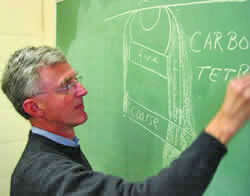Dane Conducts Cutting-edge Research at World-class DOE Lab
By: Jamie Creamer

Jacob Dane illustrates the research he conducted at the William R. Wiley Environmental Molecular Sciences Laboratory in Washington.
In the spring of 2004, CoAg Professor Jacob Dane discovered a researcher's nirvana.
It's the William R. Wiley Environmental Molecular Sciences Laboratory (EMSL), a national scientific-user facility located at the U.S. Department of Energy's Pacific Northwest National Laboratory in Richland, Washington.
"It is unbelievable," says Dane, a soil physicist in the Department of Agronomy and Soils and an Alabama Agricultural Experiment Station researcher. "I have never seen or even imagined a (research) facility this wonderful."
Dane spent two weeks conducting an intensive study of the movement and removal of three pervasive groundwater contaminants, known as dense nonaqeuous phase liquids (DNAPLs), through subsurface layers. The study required specialized, cutting-edge instruments, equipment and facilities that are unavailable at Auburn but that are the rule at EMSL, Dane says.
Because Dane's research was nonproprietary, he had use of EMSL facilities–and access to the expert assistance of a pool of 200 resident scientists and engineers–at no charge, save his travel costs.
The 200,000-square-foot state-of-the-art EMSL opened in 1997 and since has hosted more than 5,500 visiting scientists from academia, other research and development laboratories and industry who have requested use of the facility through peer-reviewed proposals. Proposals are reviewed based on scientific merit; environmental, safety and health hazards; and proprietary status.
The lab encourages fundamental research that focuses on the interaction of physical, chemical and biological processes that govern nature–research that can then be used to find new solutions to environmental problems and other critical issues facing the nation and world.
Dane's research met the criteria. The presence of DNAPLs in the subsurface is a major environmental problem worldwide in that these substances can cause widespread and long-term contamination of groundwater aquifers. Millions of dollars are spent annually by the public and private sectors to clean up sites contaminated with trichloroethylene, perchloroethylene and carbon tetrachloride, the DNAPLs Dane focused on in his research at EMSL.
"A thorough understanding of the subsurface movement of these organic contaminants is indispensable for contaminant site assessment and design of cleanup strategies," Dane says.
In his study at EMSL, Dane set up scenarios that mimicked real-life spills of the chemical solvents and then experimented with methods of removing the chemicals from the subsurface layers. A recap of Dane's project and his findings that the DNAPLs can be effectively removed through a process known as vapor extraction were published in the May-June 2004 "EMSL Monthly Report."
Calling the laboratory "an invaluable resource," Dane encourages other AU scientists to investigate the facility online at www.emsl.pnl.gov and to submit proposals to take their next-level research projects there.
